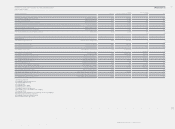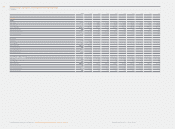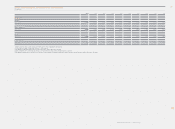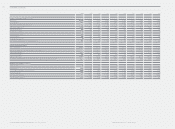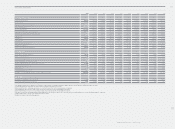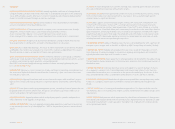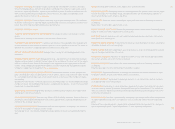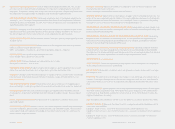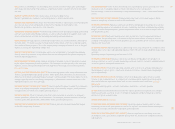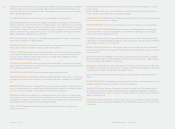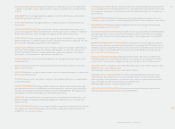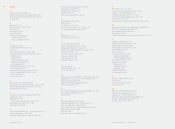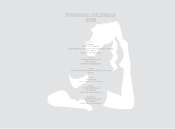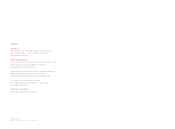Reebok 2007 Annual Report Download - page 213
Download and view the complete annual report
Please find page 213 of the 2007 Reebok annual report below. You can navigate through the pages in the report by either clicking on the pages listed below, or by using the keyword search tool below to find specific information within the annual report.
ANNUAL REPORT 2007 --- adidas Group
209SKU (STOCK KEEPING UNIT) A unique identifi cation for end product that can be ordered from
a supplier. At the adidas Group a specifi c article in a specifi c size and color is considered to be
an SKU.
SOURCING Process of managing external suppliers in order to commercialize, produce and
deliver fi nal products to customers.
SPORT FUSION Footwear and apparel products mixing performance-oriented features and
casual styles.
SPORTING GOODS CHANNEL Sports retail store, offering a very broad product range, which
usually covers apparel, footwear and hardware in a wide range of sports categories. Compared
to sport specialty shops, stores are bigger with approx. 40,000 to 50,000 square feet.
SPORT SPECIALTY Retail shop, specializing in sports products only and offering a very deep
product range (often in a limited number of sports categories) rather than a broad one. The size
of these shops is typically about 2,500 to 10,000 square feet.
STAKEHOLDERS All parties that have a direct or indirect interest in a company’s performance
and results. For the adidas Group, this includes credit providers, shareholders, consumers,
retailers, distributors, licensees, supply chain business partners, employees, international
sports bodies, non-governmental organizations, the media, etc.
SUPPLY CHAIN Refers to the system and organization from product sourcing through to end
customer delivery.
SWAPS A derivative in which two counterparties agree to exchange one stream of cash fl ows
against another stream.
SYNERGIES Additional savings or revenue growth when one combined enterprise is created from
two or more separate parts.
TAX RATE Indicates the tax rate paid by a company. Calculated by dividing taxes actually paid by
income before taxes.
TECHFIT™ POWERWEB Technology in adidas compression apparel which improves joint align-
ment and muscle balance, the link between key muscle groups to maximize power generation.
Through strategically placed TPU (thermoplastic urethane) POWERBANDs, key body parts are
linked together, further enhancing posture and athletic performance.
THE PUMP™ Custom-fi t footwear technology. The foot is surrounded with an adjustable, form-
fi tting air chamber. Infl ating the chamber by pumping the Pump Ball causes it to form to the
shape of the foot.
THIRD TIER SUPPLIER Also tier-three supplier. Supplier who provides the adidas Group’s second
tier suppliers with raw material products (e. g. polymers, compounds) used in materials and
components. see also Second Tier Supplier
TOP-DOWN, BOTTOM-UP Specifi c concept for information and knowledge processing. Informa-
tion and empowerment of management decisions is delegated from top to bottom in a fi rst step.
After going into more detail on the bottom level, the fi nal information / decision is transported
back to the top.
TORSION® SYSTEM Footwear technology comprising a lightweight arch support in the sole,
allowing the fore- and rearfoot to move independently for better surface adaptation and stability.
UEFA EURO 2008™ European Football Championship, which will take place in Austria and
Switzerland from June 7 to 29, 2008.
VOC (VOLATILE ORGANIC COMPOUNDS) Solvents that can cause breathing and health problems.
VOCs are by-products of the shoe manufacturing process. Due to health concerns, the adidas
Group has set a clear goal to steadily reduce the usage of these compounds in the production
process.
WEIGHTED AVERAGE COST OF CAPITAL (WACC) Calculation of the cost of capital according to
the debt / equity structure, utilizing a weighted average cost of capital (WACC) formula. The cost
of equity is typically computed utilizing a risk-free rate, market risk premium and a beta factor.
The cost of debt is calculated through the risk-free rate, credit spread and average tax rate.
see also Beta Factor and Market Risk Premium
WORLD CLASS BUYER PROGRAM Program launched in 2006, which aims to maximize pur-
chasing leverage across our brands. It comprises, for example, the consolidation of volumes
across our fi rst and second tier suppliers as well as the adoption of best costing practices.
WORKING CAPITAL A company’s short-term disposable capital used to fi nance the day-to-day
operations. see also Operating Working Capital
Working capital = total current assets – total current liabilities.
WORKING CAPITAL TURNOVER Shows how often a working capital item was used in and
replaced by the generation of sales in the period under review. The ratio shows how long
working capital is tied up and thus is an indicator of the volume of capital needed to generate
sales. The higher the ratio, the more positive it is deemed to be.
Working capital turnover = net sales / working capital.
WTO (WORLD TRADE ORGANIZATION) International organization founded to supervise and
liberalize international trade, located in Geneva, Switzerland.
05


